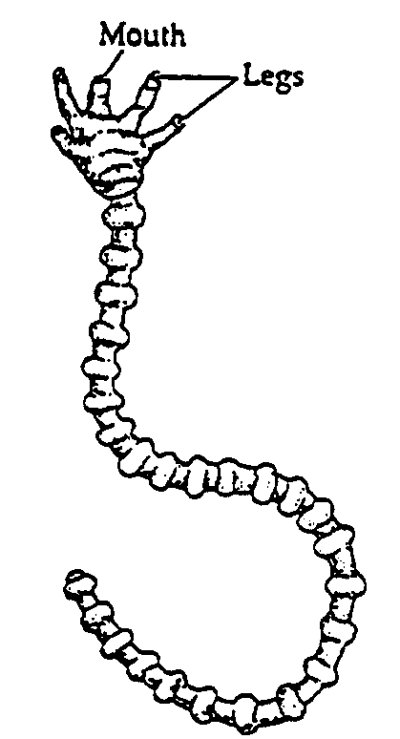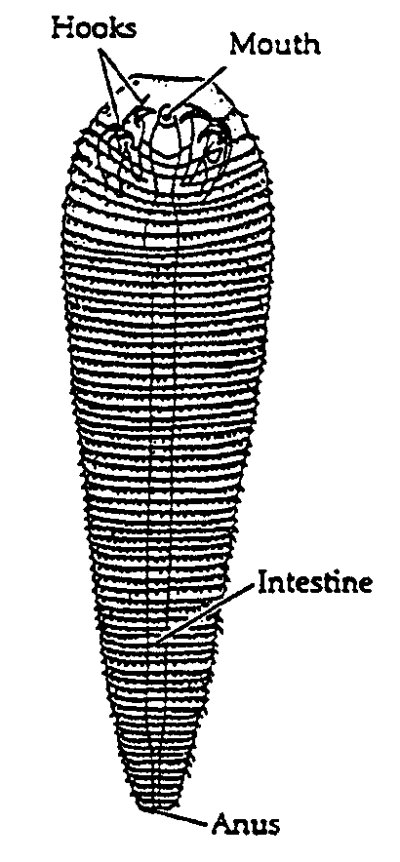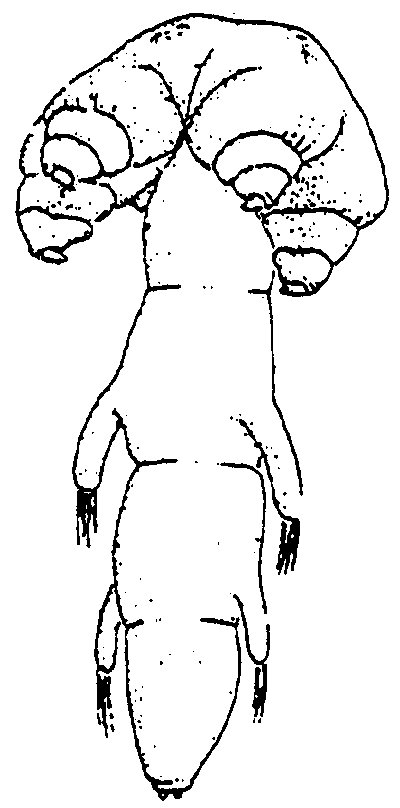| Gould, Of Tongue Worms, Velvet Worms, and Water Bears | |
 The pentastome Cephalobaena tetrapoda, a tongue worm Nancy J. Haver, after Barth and Broshears, 1982. From Invertebrates, by Richard C. and Gary J. Brusca, Sinauer Associates, 1990. With permission. circumstances. Consider, for example, the case of a class minor phylum of small membership--the Pentastomida, or tongue worms. (Their name literally means five-mouthed, in reference to the two pairs of limbs surrounding the true mouth at the anterior end. In some species the mouth resides at the end of a stalk comparable in length to the surrounding
The pentastome Linguatula serrata Nancy J. Haver, after Sedgewick, 1888. From Invertebrates, Brusca and Brusca, 1990 four legs, thus giving the appearance of a five-pointed star. The usual name of "tongue worm" commemorates the more common species that resemble a vertebrate tongue in miniature.) Pentastomes are parasites, and they live almost exclusively upon terrestrial vertebrates--a group that did not evolve until well after the Cambrian explosion. Pentastomes also resemble crustacean arthropods in a few important features. Therefore, following a century of intense debate and a range of hypotheses that either allied pentastomes with other major phyla or gave them separate status on their own, a recent consensus had emerged for viewing these intensely enigmatic creatures as a phylum evolved from a crustacean stock much later than the Cambrian explosion. And if the unique pentastomes could evolve more recently from a well-established group, why not most of the other minor phyla as well? The Cambrian explosion would then lose its exclusivity, and the "phylum-making machine" of evolution would continue to operate throughout geological time. I write this essay to present some freshly published data leading to the opposite point of view--that the Cambrian explosion is even more extensive in scope and exclusive in effect than heretofore recognized even by its partisans. These data have been presented in two papers, published in 1994 by my German paleontological colleagues Dieter Walossek and Klaus J. Muller, of the Rheinische Friedrich-Wilhelms Universitat in Bonn. Such long and technical articles on the anatomy of small Cambrian fossils invariably fall by the wayside in public perception (while often creating a quite a buzz in the tiny circle of paleontological professionals). Very few "science writers" from the journalistic side have much patience with the arcana of descriptive anatomy (and professional traditions of jargonized presentation contribute to the impasse as well). Moreover, and more sadly, taxonomy and anatomy occupy the lowest rung in the ladder of scientific status--an old-fashioned, albeit harmless and gentle, pursuit more suited to the eighteenth-century days of Linnaeus than to the modern world of molecular biology. Arthropods constitute the largest phylum by far, with major subgroups of insects, chelicerates (spiders, mites, scorpions, and horseshoe crabs), and crustaceans (crabs, shrimp, lobsters, and many other marine forms). Three minor phyla--the Onychophora, or velvet worms; the Tardigrada, or water bears; and the Pentastomida, or tongue worms--are conventionally placed near the arthropods because they possess a few key anatomical features that suggest possible genealogical proximity to this greatest of all groups. For example, the most popular recent textbook of invertebrate biology (Invertebrates, by Richard C. and Gary J. Brusca, Sinauer Associates, 1990) grants them an entire chapter, under the heading: "Three Enigmatic Groups and a Review of Arthropod Phylogeny."
The newly discovered Heymoniscambria scandica, a fossil pentastome
larva from the Upper Cambrian in Sweden that the Cambrian explosion is not so exclusive as the fossil record, read literally, might suggest--for they are usually discussed together and share all key features for putative origin in later geological time (small modern membership and absence of hard parts, leaving little opportunity for preservation of fossils); moreover, one of the three, the Pentastomida, has been widely interpreted as an offshoot of the crustacean line. We have known for the last few years
8 NATURAL HISTORY 1/95 |
|
326 |
|

